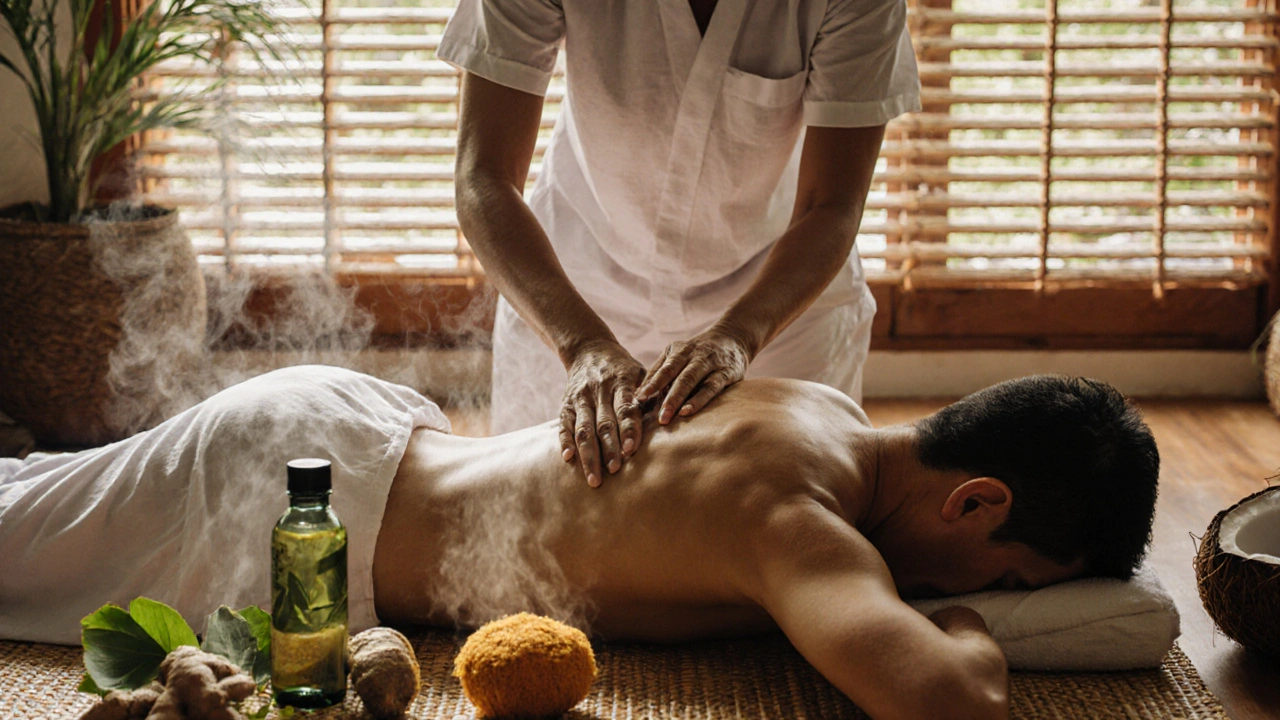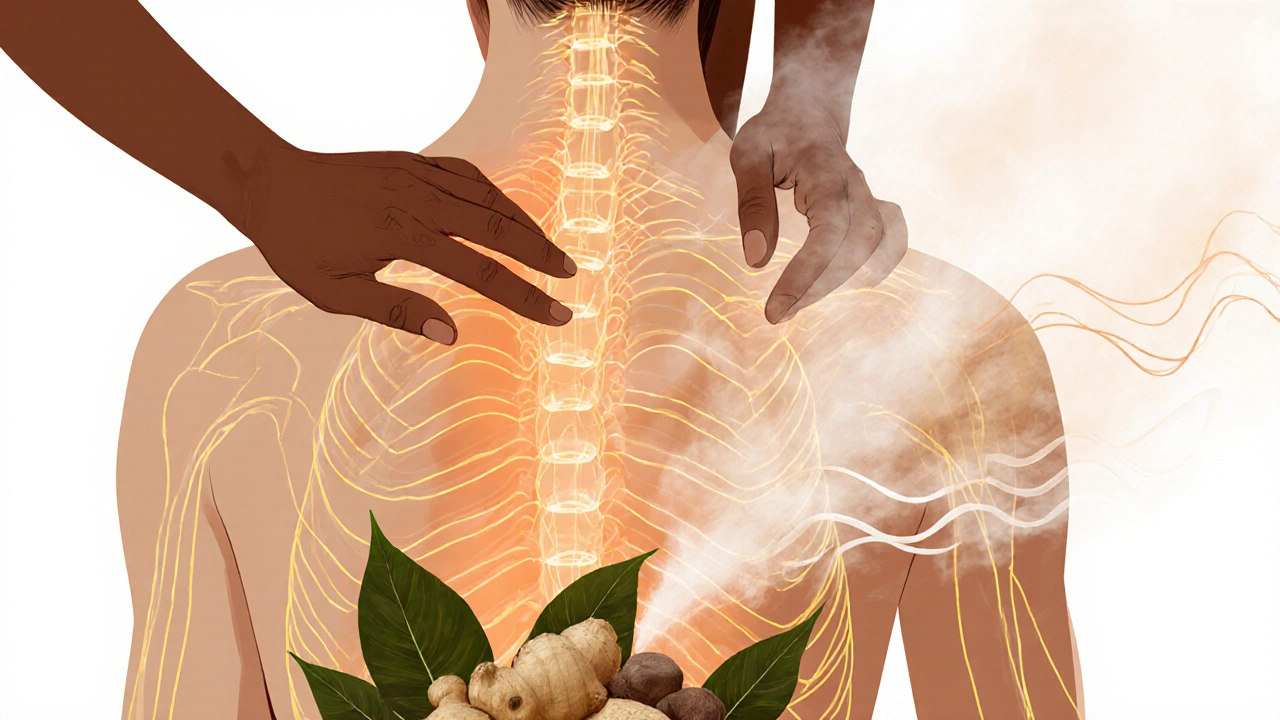The Science Behind Hilot: An Ancient Healing Art

Hilot Benefit Calculator
Calculate Your Hilot Benefits
Based on scientific research, hilot can reduce pain and improve well-being for specific conditions. Enter your details to see expected results.
Expected Results
Based on research from Journal of Bodywork and Movement Therapies and Philippine studies. Results vary by individual.
For centuries, Filipinos have relied on hilot-a hands-on healing practice passed down through generations-to treat pain, reduce stress, and restore balance. It’s not just a massage. It’s a full-body reset that combines touch, breath, and herbal remedies. While many dismiss it as folklore, modern science is starting to catch up. Research shows hilot isn’t just cultural tradition-it’s a system with measurable physiological effects.
What Exactly Is Hilot?
Hilot comes from the Filipino word hilots, meaning to rub or massage. But calling it a massage is like calling a symphony a collection of notes. A hilot session begins with assessment. The practitioner, called a manghihilot, uses their hands to feel for tension, heat shifts, and misalignments in the body. They don’t just guess-they read the body like a map.
Typical hilot treatments include deep tissue manipulation, joint mobilization, and pressure point work. Herbal poultices made from ginger, turmeric, or langka (jackfruit) leaves are often warmed and applied to sore areas. Some practitioners also use coconut oil infused with calamansi or tsaang gubat. Breathing techniques are synchronized with movements. The goal? To move stagnant energy, reduce inflammation, and realign the musculoskeletal system.
Unlike Swedish massage, which focuses on relaxation, hilot targets specific complaints: lower back pain, sprains, postpartum recovery, even fever. It’s not passive. You’re expected to participate-breathe deeply, relax your muscles, and communicate what you feel.
How Hilot Works: The Body’s Response
Modern studies are beginning to validate what generations of Filipinos already knew. A 2020 study published in the Journal of Bodywork and Movement Therapies found that participants receiving hilot for chronic lower back pain showed a 42% reduction in pain intensity after six sessions-comparable to physical therapy outcomes. The researchers noted increased blood flow to treated areas and reduced levels of cortisol, the stress hormone.
One reason hilot works is mechanical. The deep, rhythmic pressure stimulates mechanoreceptors in the skin and muscles. These receptors send signals to the brain that override pain signals-a phenomenon called gate control theory. In simple terms: your brain gets busy processing the massage, so it pays less attention to the ache.
Another mechanism is parasympathetic activation. The slow, intentional movements trigger the body’s rest-and-digest response. Heart rate slows. Blood pressure drops. Digestion improves. This is why people often feel deeply calm-or even sleepy-after a session.
Herbs used in hilot also have scientific backing. Ginger contains gingerols, compounds proven to reduce inflammation. Turmeric’s curcumin is a well-documented anti-inflammatory agent. When these are warmed and applied topically, they penetrate the skin and reach underlying tissues. A 2021 Philippine study showed topical turmeric applications reduced swelling in sprained ankles by 31% compared to placebo.
Hilot vs. Other Massage Therapies
Hilot isn’t the same as Thai massage, Shiatsu, or deep tissue massage-even though they all involve pressure. Here’s how it differs:
| Feature | Hilot | Deep Tissue | Shiatsu | Thai Massage |
|---|---|---|---|---|
| Origin | Philippines | Western | Japan | Thailand |
| Primary Goal | Energy realignment + physical healing | Break down muscle adhesions | Balance chi via acupressure | Stretching + pressure along energy lines |
| Use of Herbs | Yes, commonly | No | Occasionally | Rarely |
| Breath Coordination | Essential | Not emphasized | Some | Minimal |
| Assessment Method | Palpation + symptom history | Range of motion tests | Meridian mapping | Posture and flexibility |
Hilot stands out because it’s holistic. It doesn’t treat pain in isolation. It looks at how digestion, sleep, and emotional stress affect the body. A manghihilot might ask about your dreams, your diet, or whether you’ve been feeling emotionally heavy. That’s not superstition-it’s systems thinking. The body isn’t a collection of parts. It’s a network.

Who Benefits Most From Hilot?
Hilot isn’t a cure-all, but it’s especially effective for certain conditions:
- Chronic lower back pain: Especially in farmers, laborers, or new mothers. The technique helps realign the pelvis and release tight piriformis muscles.
- Postpartum recovery: Hilot is routinely used after childbirth to help the uterus contract, reduce swelling, and ease emotional tension. Studies show it reduces postpartum depression symptoms more than standard care alone.
- Muscle stiffness from repetitive motion: Office workers, seamstresses, and cooks often report relief after just one session.
- Arthritis discomfort: While it won’t reverse joint damage, hilot improves mobility and reduces morning stiffness by increasing synovial fluid circulation.
- Stress and anxiety: The combination of touch, breath, and herbal warmth activates the vagus nerve, which calms the nervous system.
It’s not recommended for people with open wounds, severe osteoporosis, or recent fractures. Pregnant women should only receive hilot from practitioners trained in prenatal techniques.
The Cultural Roots of Hilot
Hilot predates Spanish colonization. It was practiced by indigenous healers called babaylan, who were also spiritual leaders. The practice survived because it worked-and because it was woven into daily life. Families passed down recipes for herbal oils. Children learned to rub their parents’ backs after long days.
Unlike Western medicine, which often separates physical from emotional, hilot treats them as one. Feeling overwhelmed? The manghihilot might say your shoulders are holding your worries. That’s not poetic-it’s observation. Tension builds in specific places. The body remembers stress.
Today, hilot is experiencing a revival. Urban Filipinos are returning to it as an alternative to expensive physiotherapy. Tourists in Boracay and Cebu now seek out authentic hilot sessions. Universities in Manila and Davao have begun offering formal training programs. Some hospitals even partner with certified manghihilot for complementary care.

How to Find a Good Manghihilot
Not everyone who says they do hilot actually knows how. Here’s how to tell the real from the rushed:
- They assess before they touch. A real practitioner will ask about your symptoms, sleep, diet, and recent injuries.
- They use natural oils or herbs. If they’re using scented massage oil from a bottle, they’re probably not practicing traditional hilot.
- They don’t promise miracles. Hilot helps-but it’s not magic. If someone claims it cures cancer or diabetes, walk away.
- They work with your breathing. You should feel guided to inhale deeply during pressure points, exhale as tension releases.
- They’re open to questions. A good manghihilot can explain why they’re pressing here, not just where.
Look for practitioners certified by the Philippine Hilot Association or those recommended by local health clinics. Avoid street vendors offering 15-minute sessions for $5. Hilot is a skill, not a commodity.
What to Expect in Your First Session
Your first session usually lasts 60 to 90 minutes. You’ll lie on a mat on the floor, fully clothed in loose pants and a t-shirt. The practitioner will start by gently palpating your back, neck, and limbs. They might press a spot and ask, “Nakakasakit ba?” (“Does it hurt?”). Answer honestly.
Expect some discomfort-deep pressure is part of it-but not sharp pain. If something feels wrong, speak up. After the massage, you’ll likely be given a warm herbal compress to hold against your lower back or shoulders. You’ll be told to drink water and rest for a few hours. Some people feel lightheaded afterward. That’s normal. Your body is processing the release.
Don’t expect instant results. Most people feel better after one session. Lasting change takes three to five. Think of it like exercise. One workout won’t fix years of tension. But consistent practice? That changes everything.
Why Hilot Matters Today
In a world of pills, scans, and surgeries, hilot reminds us that healing doesn’t always require technology. Sometimes, it just needs skilled hands, time, and trust. It’s low-cost, low-risk, and deeply human.
As healthcare costs rise and burnout spreads, hilot offers something rare: a return to embodied care. It’s not about replacing medicine. It’s about remembering that the body knows how to heal-it just needs the right conditions. Hilot creates those conditions.
It’s not ancient magic. It’s ancient wisdom-with science catching up.
Is hilot the same as a regular massage?
No. Hilot includes assessment, breath coordination, herbal applications, and energy realignment. A regular massage focuses mostly on relaxation or muscle relief. Hilot treats the whole person-not just the tight spots.
Can hilot help with sciatica?
Yes. Many manghihilot specialize in nerve-related pain. By releasing tension in the piriformis muscle and improving pelvic alignment, hilot can reduce pressure on the sciatic nerve. Studies show up to 68% of patients report reduced radiating pain after four sessions.
Are the herbs used in hilot safe?
Generally yes. Common herbs like ginger, turmeric, and langka leaves are non-toxic and used topically. But if you have sensitive skin or allergies, ask the practitioner first. Some may use camphor or menthol-these can irritate certain individuals.
How often should I get hilot?
For acute pain, once a week for 3-4 weeks is typical. For maintenance, every 2-4 weeks works well. If you’re stressed or physically active, monthly sessions help prevent buildup. Listen to your body-if you feel better after two weeks, wait. Don’t force it.
Can I learn hilot myself?
You can learn basic techniques for family use-like rubbing a child’s back or helping a partner with sore shoulders. But proper hilot requires training. It’s not just pressure. It’s timing, intention, and diagnosis. Take a course if you’re serious. Many community centers in the Philippines offer affordable workshops.





